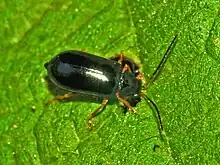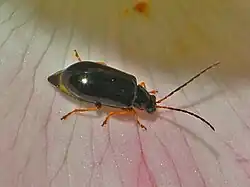| Luperus longicornis | |
|---|---|
 | |
| Scientific classification | |
| Domain: | Eukaryota |
| Kingdom: | Animalia |
| Phylum: | Arthropoda |
| Class: | Insecta |
| Order: | Coleoptera |
| Infraorder: | Cucujiformia |
| Family: | Chrysomelidae |
| Subfamily: | Galerucinae |
| Tribe: | Luperini |
| Genus: | Luperus |
| Species: | L. longicornis |
| Binomial name | |
| Luperus longicornis (Fabricius, 1781) | |
| Synonyms | |
| |
Luperus longicornis is a skeletonizing leaf beetle belonging to the family Chrysomelidae, subfamily Galerucinae. The species was first described by Johan Christian Fabricius in 1781.
Distribution
This species can be found in the whole Palearctic realm and in the Near East.

Female
Description
Luperus longicornis can reach a body length of about 4–5 mm (0.16–0.20 in). These beetles have black bodies and orange legs. The males generally have longer antennae than their female counterparts.
Biology
The larvae feed on grass roots and pass winter in the larval stage, as development is completed in the spring. Adults mainly feed on leaves of willows (Salix species) and birch, but also on Rosaceae species and on foliage of several trees (Populus tremula, Quercus robur, etc.).
External links
This article is issued from Wikipedia. The text is licensed under Creative Commons - Attribution - Sharealike. Additional terms may apply for the media files.